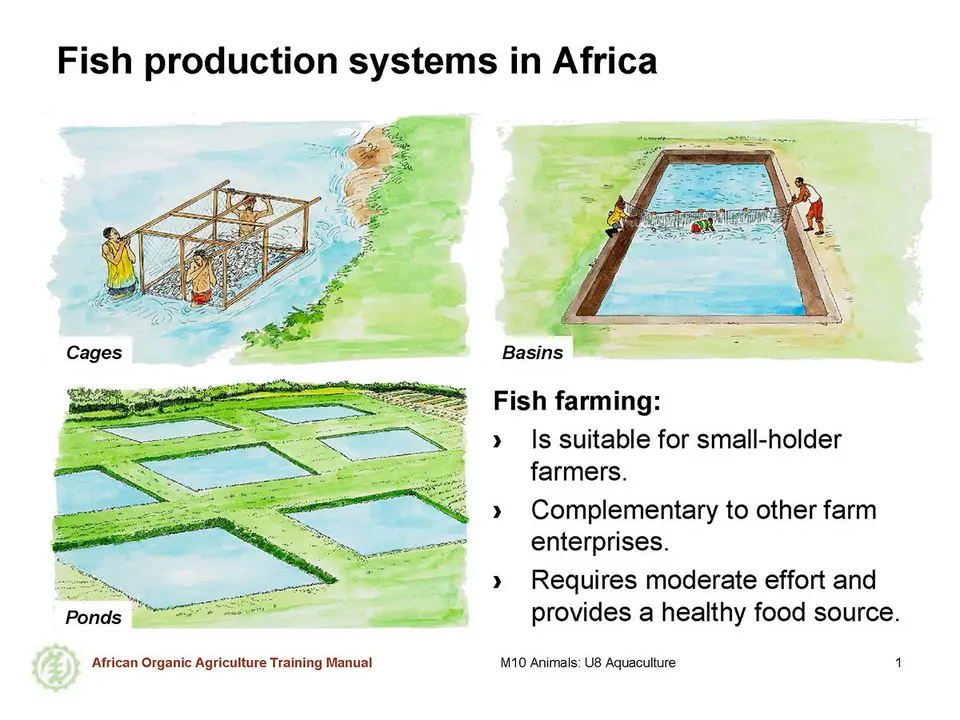Introduction
Consumption of fish per capita in sub-Saharan Africa has lagged behind that of the rest of the world, partly due to the low supply of fish products. However, aquaculture, especially fish culture (farming), is increasing. Commercial finfish culture in fresh or brackish water is now common, with Nigeria, Ivory Coast, Zimbabwe, Kenya and South Africa being the leading producers. Marine shrimp culture is concentrated in Madagascar, although a few farms are found in Seychelles, Mozambique and Kenya. Aquaculture is estimated to be 95 percent small-scale, characterized by one or more small ponds of 100 to 500 m2 in size, with fish ponds integrated into the rest of the agricultural activities.
Aquaculture is the production of all forms of aquatic animals such as fish and crustaceans or aquatic plants such as algae in fresh, brackish or salt water. In freshwater, mainly fish and some species of freshwater-prawns are raised. Although fish can also be raised by fencing-off or using net-cages in a swamp or a lake, the most efficient way to grow most fish is in a domesticated pond system. In this chapter, we will, therefore, discuss production practices based on this system.
Fish farming in ponds offers different advantages:
- It is a suitable system for small-holder farmers especially in regions where water is available in sufficient quantities. Fish is an excellent source of protein for the family and can be supplied or sold to other people in rural areas.
- It is complementary to other farming activities. Most cultured fish species are omnivorous meaning that they are not very selective regarding their food. They can be fed on-farm products such as rice bran, leftover sugar cane, soybean cake and other remnants of plant and food production. They also feed on insects, other fish, snails or other animals that are naturally available in the pond.
- The water from the pond and pond sediments are rich in nitrogen and phosphorus and can be used to irrigate and fertilize crop gardens.
However, fish pond production varies depending on the environment and the species involved. Generally, they can be categorised depending on size and/or intensity of management as follows:
Small-scale aquaculture includes extensive or semi-intensive pond production operated by the farmer and his/her household and integrated to varying degrees with other agricultural enterprises. Tilapias and/or catfish (Clarias or Heterobranchus species) are commonly raised with some limited carp production, mostly Cyprinus carpio. This scale of production primarily relies on on-farm inputs including organic fertilizers and simple supplementary feeds, and most of the labour is provided by the family. Small-scale fish production generally requires minimum capital investment and is not mechanized. Most of the fish harvest is consumed by the family and any excesses are sold to neighbouring markets.
Commercial aquaculture involves large-scale production normally having a water surface area of about five hectares or more. Such production tends to be more capital intensive, relying on wage labour, external inputs and mechanization. Commercial aquaculture is common in the Ivory Coast (Chrysichthys, Clarias and tilapia), Nigeria (Clarias, Heterobranchus, tilapia and carp), Zambia (tilapia and carp), Zimbabwe and Kenya (trout and tilapia), and South Africa (trout).
Challenges to aquaculture in Africa
Aquaculture or fish farming, in particular in Africa, is still facing several challenges, some of which include:
- Limited knowledge on fish farming - There is a general lack of adequately trained personnel to undertake aquaculture extension activities with farmers as well as limited access to good quality information. The few trained workers are mainly employed in research while the majority still need proper orientation in practical aquaculture. Specific knowledge on pond establishment, proper feeding, health management and good harvesting and restocking practices is still very low.
- Limited land and water resources - In some places, there is neither sufficient land nor enough available water to support successful aquaculture. The growing concerns about environmental conservation are also limiting production systems under swampy or mangrove ecosystems.
- High investments - Establishing aquaculture in ponds commonly involves high investments in terms of labour for digging the ponds and the costs of maintaining the ponds. This is further worsened by the general scarcity of affordable long-term investment capital for aquaculture.
- Limited availability of quality inputs - The limited availability and high cost of fish stock and feed is a critical constraint to the development of aquaculture. Fish feeds like fishmeal are not easily accessible and the cost is not affordable to most small-scale producers. Access to production inputs is further limited by the poor infrastructure and poor aquaculture extension services.
On the positive side, it is generally accepted that there is significant potential for growth of aquaculture. Labour is available and economical, while the demand for fish is high and often unsatisfied. In many areas, land and water resources are still readily available and underutilised. Adoption of aquaculture is therefore a complementary means of providing better nutrition and incomes to farming households.
However, there is the need to adopt appropriate management practices taking care of environmental protection and the sustainable use of aquatic resources as well as the food safety requirements. Organic aquaculture aims at meeting these challenges and establishing a sustainable farm activity that is well-integrated into the farming system and provides safe, additional income to small-holder farmers in Africa.
Assessment of local fish farming activities
Inquire among the farmers about fish farming in the area by asking the following questions:
- What do you know about fish farming?
- Are there any farmers growing fish in the area?
- How many farmers are growing fish and how big are their farms?

 tap and then scroll down to the Add to Home Screen command.
tap and then scroll down to the Add to Home Screen command.